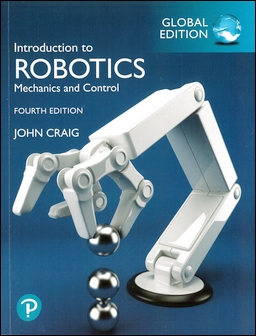Introduction to Robotics: Mechanics and Control 4/e
作者:John Craig
原價:NT$ 1,480
內容介紹
本書特色
目錄
Description
An intuitive introduction to robotic theory and application
Since its original publication in 1986, Craig’s Introduction to Robotics: Mechanics and Control has been the leading textbook for teaching robotics at the university level. Blending traditional mechanical engineering material with computer science and control theoretical concepts, the text covers a range of topics, including rigid-body transformations, forward and inverse positional kinematics, velocities and Jacobians of linkages, dynamics, linear and non-linear control, force control methodologies, mechanical design aspects, and robotic programming.
The 4th Edition features a balance of application and theory, introducing the science and engineering of mechanical manipulation--establishing and building on foundational understanding of mechanics, control theory, and computer science. With an emphasis on computational aspects of problems, the text aims to present material in a simple, intuitive way.
分類位置:
理工 > 機械工程 > 機器人學
Features
-
Real-world applications present underlying theories in simple, understandable ways. This practicality helps students learn how to write algorithms to perform required computations.
-
End-of-chapter exercises feature “difficulty grades” so instructors can assign to students and easily implement a grade-point plan.
-
Programming Assignments at the end of each chapter emphasize concepts from a software perspective.
-
A balanced approach presents robotics concepts from mechanical, control theory, and computer science subdisciplines.
-
NEW! Additional exercises have been added to the end of each chapter.
-
UPDATED! New references, materials, and figures account for changing technology and reflect today’s robotics landscape.
-
REVISED! More than 100 minor typos have been corrected throughout the text.
-
NEW! Two sections have been added, including Section 8.9 on optical encoders and Section 10.9 on adaptive control.
New to this Edition
-
Additional exercises have been added at the end of each chapter.
-
New section 8.9 added on optical encoders.
-
New section 10.9 added on adaptive control.
-
Updated material and references for changing technology and today’s robotics landscape.
-
Several new or updated figures.
-
More than 100 minor typos and other errors corrected.
Table of Contents
1. Introduction
2. Spatial Transformations
3. Forward Kinematics
4. Inverse Kinematics
5. Velocities, Static Forces, and Jacobians
6. Dynamics
7. Trajectory Planning
8. Mechanical Design of Robots
9. Linear Control
10. Non-Linear Control
11. Force Control
12. Programming Languages and Systems
13. Simulation and Off-Line Programming
上一則
|
回上頁
|
下一則



